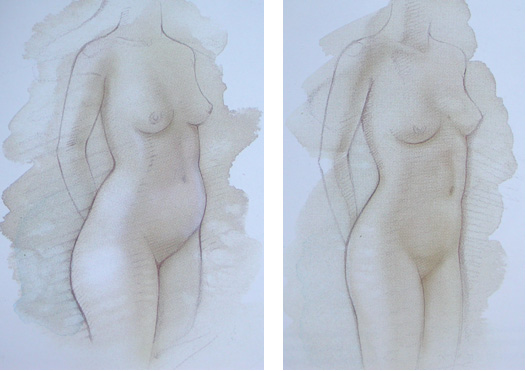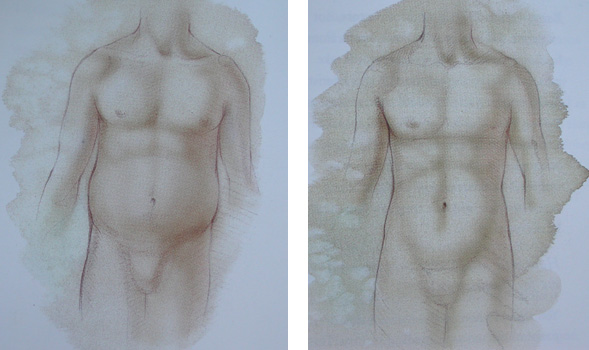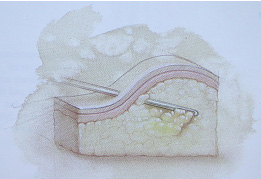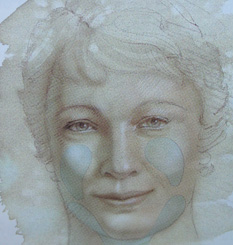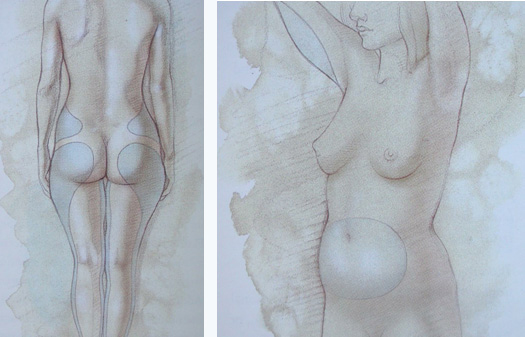Liposuction, also known as lipoplasty and suction lipectomy, is a procedure that can enable you to get rid of excess fat deposits in certain parts of your body, as well as in the face and neck. For example, it can slim your hips and thighs, flatten your tummy, reshape your calf and wrist, or improve your creased under-chin region.
If you consider liposuction, your plastic surgeon will ask you to be fully informed about this procedure. In fact, reading this brochure is the first step towards that purpose. Talking with your surgeon face-to-face is the best way to get other information you need.
Deciding on surgery....
Liposuction is suitable especially for men and women who are not overweight but have isolated fat deposits that cause disproportional appearance in certain parts of their body. Such localized fat deposits are sometimes inherited as a personal feature, and typically do not respond to diet and exercise. Liposuction is the only way to get rid of this problem.
|
|
|
|
Liposuction is a treatment that can be performed at all ages. You will get the best results if your skin is still elastic enough to be tight after the removal of the fat. Some elderly patients, whose skin has lost its elasticity, may not respond well to the treatment, and they may need a skin tightening surgery as an additional surgical procedure.
|
|
| Liposuction is a very popular surgery for men as well. It is especially useful for the fat deposits around the waist (left). After liposuction, the body gets slimmer and gains a smoother appearance (right). |
Are you a suitable candidate for liposuction.....?
If you want improvement in the contours of the body parts listed below, or if you have regional excess fat, you are a good candidate for liposuction.
• Cheeks, chin and neck
• Upper arms
• Breast and chest area
• Abdomen and waist
• Hips
• Inner and outer sides of the thigh
• Inner side of the knee
• Calf and wrists
Liposuction can also be used to treat excessive breast enlargement known as gynecomastia, which can be seen in any young or adult man. Liposuction should be considered as a procedure to be performed alone for achieving weight loss or for the treatment of cellulite (a condition that gives the skin a bumpy and dimpled appearance). Alternative treatments should be considered for solving these problems.
Liposuction, a procedure that can be performed for many parts of the body, can also be performed in conjunction with other plastic surgery procedures.
Your personal consultation....
Since everyone has unique physical characteristics, not everyone can achieve the same result after liposuction. Your plastic surgeon will consider your physical characteristics when determining the most effective treatment procedure. During the consultation, he/she will ask you about the areas where you want improvement. The questions will help your plastic surgeon understand your expectations and determine what can and cannot be realistically achieved after surgery.
How will my plastic surgeon evaluate me for liposuction....?
You should definitely attend the consultation for discussing your medical history. Your medical history will contain information about your medical conditions (if any), such as diabetes, high blood pressure, or heart disease. Your physician will want to know the surgical operations you have had, the medical treatments you have received, and the medications you currently take. It is very important for you to give such information completely. Your current weigh and whether you plan to gain or lose weight in the future will be determining factors to consider in evaluating you for liposuction procedure. Your surgeon may ask you questions about the effects of your previous weight losses (if any) on the appearance of the regions that you now want to correct. He/she will calculate the elasticity of your skin and estimate the optimum amount of fat removal required for achieving the best results.
How is liposuction performed?
First, a small tube called a cannula is inserted through one or more small incisions made in places close the area of fat removal, and then the fat removal is performed.
The lengths of incisions are generally less than 1 cm and mostly made in skin folds and natural body lines, in such a way as to remain unnoticeable scars. The cannula is connected to a device that creates vacuum pressure through a plastic tube. During the procedure, the suction device vacuums the unwanted fat out of the body.
|
|
| The fat removal process is carried out with a cannula inserted under the skin through a small incision. Fat cells are aspirated from deep or superficial areas depending on the selected technique. |
What are the differences between the common liposuction techniques?
Before the liposuction procedure, a special liquid is administered to the fat removal area. The plastic surgeon may use the dry technique, the tumescent technique in which a large amount of fluid is administered, or other techniques. The use of other options is determined by the type of the equipment used or whether the fat is absorbed from the deep or superficial layer. Which fat removal technique is the most advantageous for you depends on many factors, which your surgeon will discuss with you.
|
|
| With liposuction, excess fat in the cheeks, neck and jawbone area can be removed as well. |
|
|
| Dark appearance of the areas that can be treated with liposuction; thin cannulas should be used on the inner and outer sides of the knee and the ankles (left). The abdominal region responds well to liposuction. Liposuction may also be effective in the arms of some patients (right). |
Understanding the risks...
Serious complications of liposuction are quite rare. Every year, thousands of people have liposuction and become satisfied with the results obtained without significant problems. However, anyone who considers this procedure should be aware of its both benefits and risks. However, patients do not face any problem after liposuction procedures performed by the right physicians.
I’m aware of the fact that every surgical procedure carries certain risks, but how can I get more information to make a decision more consciously.
During the consultation with your surgeon, you will be told about the potential risks of this surgical procedure and risks of surgery in general. There is a possibility of blood accumulation under the skin, but this is normally a self-resolving problem. Some patients may develop contour irregularities including dimples or wrinkles on their skin; however, such conditions can only be observed after liposuction procedures performed by inexperienced hands.
You can help reduce risks by following the advices and instructions of your plastic surgeon before and after surgery.
Your surgical process...
The aim of your plastic surgeon and the whole team is to enable you to have your surgical operation as easy and comfortable as possible.
How should I prepare for surgery.....?
You should stop using aspirin and some anti-inflammatory drugs for a while before surgery, as they may cause increase in bleeding. Before the surgery, your surgeon will give you additional information. Depending on the extent of the surgery and the type of anesthesia performed, you may need a patient accompanist who will take you home and accompany you for at least one night.
What kind of day will the day of surgery be....?
Your liposuction surgery should be performed in the operating room in a hospital. Medications will be administered to avoid discomfort during the surgical procedure. For your safety, you will be monitored during the operation for the purpose of uninterrupted control of heart, blood pressure, pulse, and oxygen amount in blood circulation. You will wear a special corset after the operation. The surgeon will tell you how long you should wear the corset, and will also give you instructions on how to take off the corset when taking a shower or bath.
What will my initial appearance and feelings be like....?
It is important to understand the fact that the time needed for recovery differs from person to person. The day after surgery, you will start light movements that will support blood circulation. Your plastic surgeon will recommend you to limit your movements for the first few postoperative days.
You should not take Aspirin or anti-inflammatory drugs. You will observe swelling and bruises after the surgery. These are normal and expected consequences. The swelling usually starts subsiding spontaneously after a week or a little bit later. Disappearance of the bruises takes three weeks or longer. In addition, numbness may occur in some areas, and the return of the sensations may take three to five weeks. But if you have reached the right surgeon, such bruises will be comparatively less. Sutures are removed within 7 days after surgery.
When will I be able to return to my normal activities....?
You will I be able to return to work after a few days. As observed in many cases, you will I be able to return to most of your normal activities and then start some exercise within a week or two. It may also take longer depending on the scope of the surgical operation.
What are the possible consequences of liposuction....?
Liposuction reduces fat deposits, which form bulges in your body, causing you to feel uncomfortable or shy when taking off your clothes. Factors such as the prolonged swelling period after surgery may cause you to get your new appearance and slimmer lines later. Healing is a gradual process that requires you to wait for a certain period of time to completely enjoy the results of liposuction. After a detailed review, sometimes a better appearance of the fat removal area may be desired, and in such a case, an additional application can be performed accordingly, under local anesthesia in your plastic surgeon’s office.
How long will the results last....?
Liposuction gives long-lasting results as long as you maintain your weight after the surgery. However, even if you gain a few pounds, you will notice adiposity, especially in areas that have had problems in the past. Nevertheless, adiposity in these areas will be less compared to other parts of your body.
Keeping in touch with your plastic surgeon....
When you visit your plastic surgeon at his/her office at predetermined intervals for the follow up of the healing, the progress in the healing process is evaluated. Many surgeons recommend you to go for periodic checkups to reexamine you and discuss the long term results of the surgical operation.
Please always remember that your relationship with your plastic surgeon will not end after you leave the operating room. You should contact your surgeon when you have questions and concerns about the recovery period or need more information at a later time.
If you are sure that you want liposuction for yourself first, you are ready to plan your surgery. Your plastic surgeon is aware of the fact that this is an important decision for your life.
Your plastic surgeon is first and foremost a physician who prioritizes your general well-being. He/she will strive to enable you to benefit from liposuction as much as possible, by using the surgical skills he/she has developed over the course of many years with intense practices and experiences.
Teşekkürler
Prof.Dr. Serdar Öztürk

